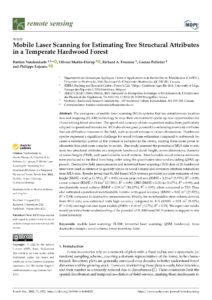
Abstract :
The emergence of mobile laser scanning (MLS) systems that use simultaneous localization and mapping (SLAM) technology to map their environment opens up new opportunities for characterizing forest structure. The speed and accuracy of data acquisition makes them particularly adapted to operational inventories. MLS also shows great potential for estimating inventory attributes that are difficult to measure in the field, such as wood volume or crown dimensions. Hardwood species represent a significant challenge for wood volume estimation compared to softwoods because a substantial portion of the volume is included in the crown, making them more prone to allometric bias and more complex to model. This study assessed the potential of MLS data to estimate tree structural attributes in a temperate hardwood stand: height, crown dimensions, diameter at breast height (DBH), and merchantable wood volume. Merchantable wood volume estimates were evaluated to the third branching order using the quantitative structural modeling (QSM) approach. Destructive field measurements and terrestrial laser scanning (TLS) data of 26 hardwood trees were used as reference to quantify errors on wood volume and inventory attribute estimations from MLS data. Results reveal that SLAM-based MLS systems provided accurate estimates of tree height (RMSE = 0.42 m (1.78%), R² = 0.93), crown projected area (RMSE = 3.23 m² (5.75%), R² = 0.99), crown volume (RMSE = 71.4 m³ (23.38%), R² = 0.99), DBH (RMSE = 1.21 cm (3.07%), R² = 0.99), and merchantable wood volume (RMSE = 0.39 m³ (18.57%), R² = 0.95), when compared to TLS. They also estimated operational merchantable volume with good accuracy (RMSE = 0.42 m³ (21.82%), R² = 0.94) compared to destructive measurements. Finally, the merchantable stem volume derived from MLS data was estimated with high accuracy compared to TLS (RMSE = 0.11 m³ (8.32%), R² = 0.96) and regional stem taper models (RMSE = 0.16 m³ (14.7%), R² = 0.93). We expect our results would provide a better understanding of the potential of SLAM-based MLS systems to support in-situ forest inventory.
Consultez la notice complète de l’article sur ORBi
